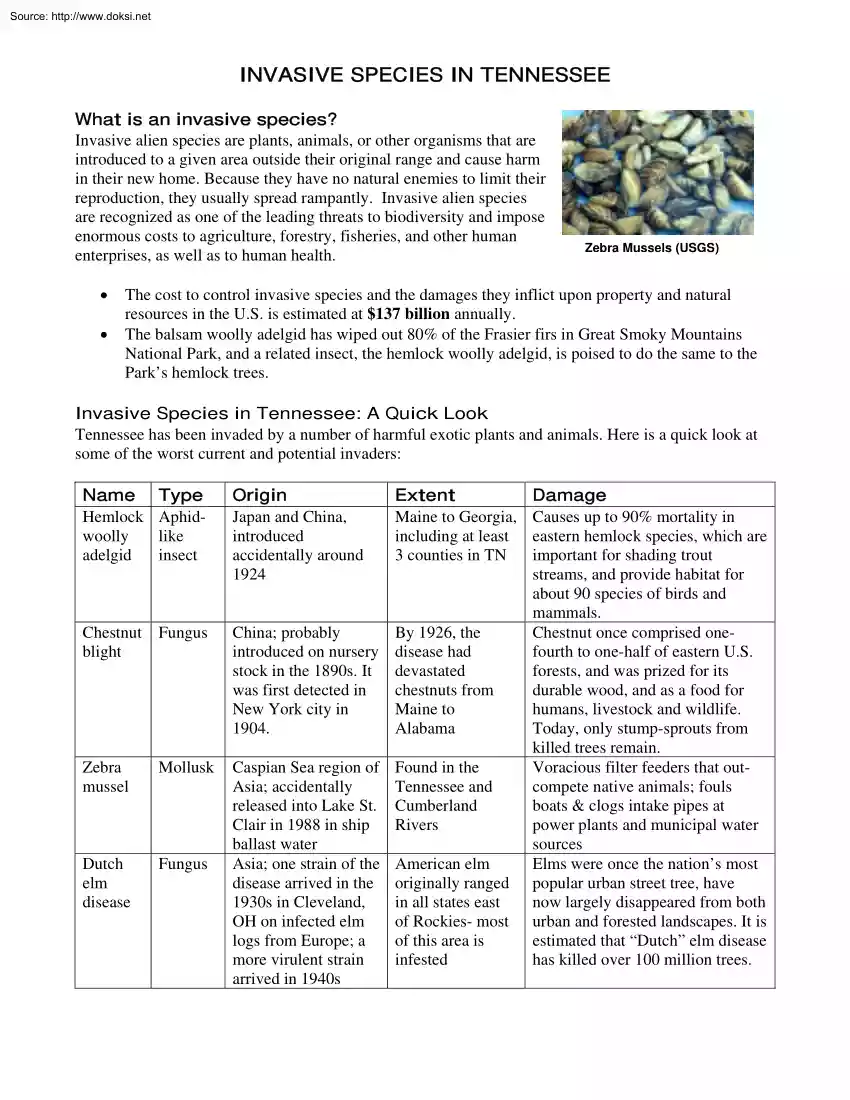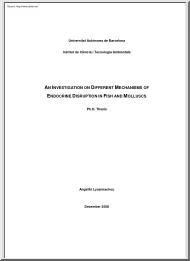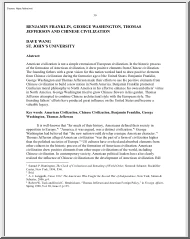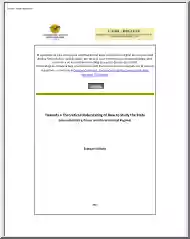Please log in to read this in our online viewer!

Please log in to read this in our online viewer!
No comments yet. You can be the first!
What did others read after this?
Content extract
Source: http://www.doksinet INVASIVE SPECIES IN TENNESSEE What is an invasive species? Invasive alien species are plants, animals, or other organisms that are introduced to a given area outside their original range and cause harm in their new home. Because they have no natural enemies to limit their reproduction, they usually spread rampantly. Invasive alien species are recognized as one of the leading threats to biodiversity and impose enormous costs to agriculture, forestry, fisheries, and other human enterprises, as well as to human health. • • Zebra Mussels (USGS) The cost to control invasive species and the damages they inflict upon property and natural resources in the U.S is estimated at $137 billion annually The balsam woolly adelgid has wiped out 80% of the Frasier firs in Great Smoky Mountains National Park, and a related insect, the hemlock woolly adelgid, is poised to do the same to the Park’s hemlock trees. Invasive Species in Tennessee: A Quick Look Tennessee
has been invaded by a number of harmful exotic plants and animals. Here is a quick look at some of the worst current and potential invaders: Name Hemlock woolly adelgid Type Aphidlike insect Origin Japan and China, introduced accidentally around 1924 Extent Maine to Georgia, including at least 3 counties in TN Chestnut blight Fungus China; probably introduced on nursery stock in the 1890s. It was first detected in New York city in 1904. By 1926, the disease had devastated chestnuts from Maine to Alabama Zebra mussel Mollusk Found in the Tennessee and Cumberland Rivers Dutch elm disease Fungus Caspian Sea region of Asia; accidentally released into Lake St. Clair in 1988 in ship ballast water Asia; one strain of the disease arrived in the 1930s in Cleveland, OH on infected elm logs from Europe; a more virulent strain arrived in 1940s American elm originally ranged in all states east of Rockies- most of this area is infested Damage Causes up to 90% mortality in eastern
hemlock species, which are important for shading trout streams, and provide habitat for about 90 species of birds and mammals. Chestnut once comprised onefourth to one-half of eastern U.S forests, and was prized for its durable wood, and as a food for humans, livestock and wildlife. Today, only stump-sprouts from killed trees remain. Voracious filter feeders that outcompete native animals; fouls boats & clogs intake pipes at power plants and municipal water sources Elms were once the nation’s most popular urban street tree, have now largely disappeared from both urban and forested landscapes. It is estimated that “Dutch” elm disease has killed over 100 million trees. Source: http://www.doksinet Name Fire Ant Type Insect Origin South America; accidentally introduced to Alabama in 1930s Extent 300 million acres of Southern U.S, including 38 counties in TN Damage Aggressive, multiple biter with painful venom and chance of allergy; may also damage fruits, berries and young
crops; also damage electric boxes; ant mounds are a hazard to farm equipment. What Congress Can Do: A. Make Prevention Our Top Priority • Reverse current U.S policy on the intentional import of live plants and animals, that is, switch from a “dirty” to a “clean” list approach that requires screening for invasiveness before import and which keeps out or limits import of species so as to prevent harm to native species or ecosystems – and make the legislative changes to do so. • Substantially cut the unintentional introduction of aquatic invaders by overseeing federal standardsetting on the discharge of ballast water in the United States, supporting the development of technology to meet these standards; ensuring that agencies monitor and enforce compliance; and reauthorizing the 1996 National Invasive Species Act in the strongest and most comprehensive form. • When considering, reviewing, or approving trade agreements, rigorously address invasive species, e.g, by allowing
for restriction of imports of non-native species that are invasive elsewhere and by identifying pathways by which inadvertent introductions travel so that they may be interrupted. B. Make Federal Agencies More Effective • Use oversight authority to ensure that all federal agencies immediately and strongly implement that part of Executive Order 13112 that asks them to identify and reduce actions that introduce or spread invasive species in the United States or elsewhere. • Appropriate adequate funds so that federal agencies have the resources to address invasive species problems promptly and comprehensively over the long-term. • Strengthen the structure and leadership of the National Invasive Species Council and prompt more aggressive implementation of its National Management Plan. • Oversee the work of the U.S Department of Agriculture’s Animal and Plant Health Inspection Service to ensure that the agency and its Administrator are committed to protecting biological diversity
as well as agriculture. • Evaluate the serious problems with border inspection for pests, weeds, and pathogens, e.g, in staffing and cross-department coordination, exacerbated by moving these functions into the Department of Homeland Security and amend its authorizing legislation if needed. References: Forest Pathology.org Chestnut Blight http://wwwforestpathologyorg/dis chestnuthtml How to Identify and Manage Dutch Elm Disease. http://nafsfedus/spfo/pubs/howtos/ht ded/ht dedhtm#intro Tennessee Department of Agriculture. Imported Fire Ants http://wwwstatetnus/agriculture/regulate/plants/ifahtml USDA Forest Service. Hemlock Woolly Adelgid Page http://wwwfsfedus/na/morgantown/fhp/hwa/hwasitehtml USGS Zebra Mussel Page. http://naserusgsgov/taxgroup/mollusks/zebramussel/ For more information, please contact Aimee Delach at Defenders of Wildlife 202-682-9400 x271 adelach@defenders.org
has been invaded by a number of harmful exotic plants and animals. Here is a quick look at some of the worst current and potential invaders: Name Hemlock woolly adelgid Type Aphidlike insect Origin Japan and China, introduced accidentally around 1924 Extent Maine to Georgia, including at least 3 counties in TN Chestnut blight Fungus China; probably introduced on nursery stock in the 1890s. It was first detected in New York city in 1904. By 1926, the disease had devastated chestnuts from Maine to Alabama Zebra mussel Mollusk Found in the Tennessee and Cumberland Rivers Dutch elm disease Fungus Caspian Sea region of Asia; accidentally released into Lake St. Clair in 1988 in ship ballast water Asia; one strain of the disease arrived in the 1930s in Cleveland, OH on infected elm logs from Europe; a more virulent strain arrived in 1940s American elm originally ranged in all states east of Rockies- most of this area is infested Damage Causes up to 90% mortality in eastern
hemlock species, which are important for shading trout streams, and provide habitat for about 90 species of birds and mammals. Chestnut once comprised onefourth to one-half of eastern U.S forests, and was prized for its durable wood, and as a food for humans, livestock and wildlife. Today, only stump-sprouts from killed trees remain. Voracious filter feeders that outcompete native animals; fouls boats & clogs intake pipes at power plants and municipal water sources Elms were once the nation’s most popular urban street tree, have now largely disappeared from both urban and forested landscapes. It is estimated that “Dutch” elm disease has killed over 100 million trees. Source: http://www.doksinet Name Fire Ant Type Insect Origin South America; accidentally introduced to Alabama in 1930s Extent 300 million acres of Southern U.S, including 38 counties in TN Damage Aggressive, multiple biter with painful venom and chance of allergy; may also damage fruits, berries and young
crops; also damage electric boxes; ant mounds are a hazard to farm equipment. What Congress Can Do: A. Make Prevention Our Top Priority • Reverse current U.S policy on the intentional import of live plants and animals, that is, switch from a “dirty” to a “clean” list approach that requires screening for invasiveness before import and which keeps out or limits import of species so as to prevent harm to native species or ecosystems – and make the legislative changes to do so. • Substantially cut the unintentional introduction of aquatic invaders by overseeing federal standardsetting on the discharge of ballast water in the United States, supporting the development of technology to meet these standards; ensuring that agencies monitor and enforce compliance; and reauthorizing the 1996 National Invasive Species Act in the strongest and most comprehensive form. • When considering, reviewing, or approving trade agreements, rigorously address invasive species, e.g, by allowing
for restriction of imports of non-native species that are invasive elsewhere and by identifying pathways by which inadvertent introductions travel so that they may be interrupted. B. Make Federal Agencies More Effective • Use oversight authority to ensure that all federal agencies immediately and strongly implement that part of Executive Order 13112 that asks them to identify and reduce actions that introduce or spread invasive species in the United States or elsewhere. • Appropriate adequate funds so that federal agencies have the resources to address invasive species problems promptly and comprehensively over the long-term. • Strengthen the structure and leadership of the National Invasive Species Council and prompt more aggressive implementation of its National Management Plan. • Oversee the work of the U.S Department of Agriculture’s Animal and Plant Health Inspection Service to ensure that the agency and its Administrator are committed to protecting biological diversity
as well as agriculture. • Evaluate the serious problems with border inspection for pests, weeds, and pathogens, e.g, in staffing and cross-department coordination, exacerbated by moving these functions into the Department of Homeland Security and amend its authorizing legislation if needed. References: Forest Pathology.org Chestnut Blight http://wwwforestpathologyorg/dis chestnuthtml How to Identify and Manage Dutch Elm Disease. http://nafsfedus/spfo/pubs/howtos/ht ded/ht dedhtm#intro Tennessee Department of Agriculture. Imported Fire Ants http://wwwstatetnus/agriculture/regulate/plants/ifahtml USDA Forest Service. Hemlock Woolly Adelgid Page http://wwwfsfedus/na/morgantown/fhp/hwa/hwasitehtml USGS Zebra Mussel Page. http://naserusgsgov/taxgroup/mollusks/zebramussel/ For more information, please contact Aimee Delach at Defenders of Wildlife 202-682-9400 x271 adelach@defenders.org




 Just like you draw up a plan when you’re going to war, building a house, or even going on vacation, you need to draw up a plan for your business. This tutorial will help you to clearly see where you are and make it possible to understand where you’re going.
Just like you draw up a plan when you’re going to war, building a house, or even going on vacation, you need to draw up a plan for your business. This tutorial will help you to clearly see where you are and make it possible to understand where you’re going.